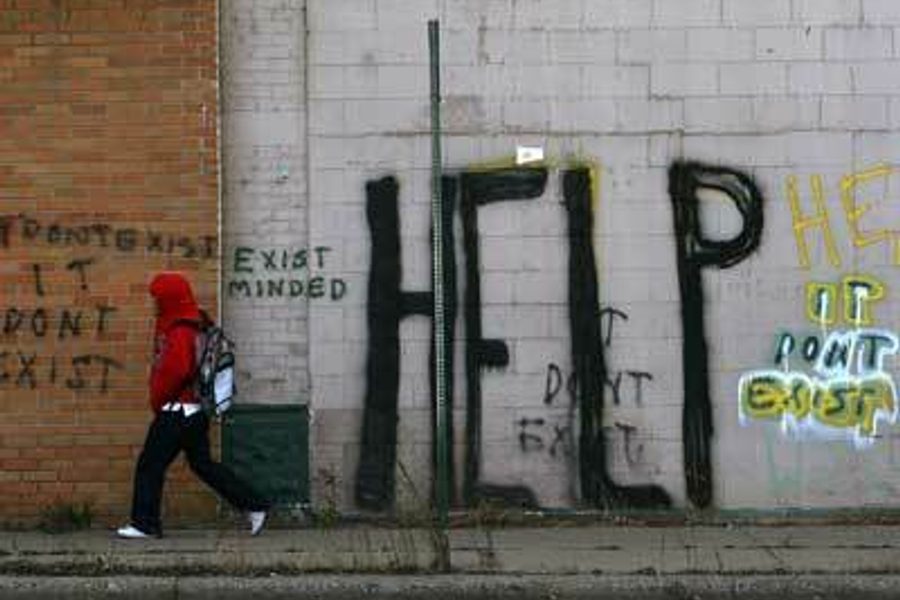
Motown is now known as “Notown,” according to a Time magazine cover headline from a few weeks ago.
The visual symbols of Detroit’s decline are stunning. Factories that supplied tanks, planes, and trucks for the U.S. victory in World War II are vacant, windowless shells — or have been leveled, leaving behind pieces of scarred concrete and twisted metal among the weeds. Some areas have had vast expanses return to nature, with pheasants returning to Detroit to roost among the wild, uncontrolled brush that has replaced rows of demolished homes.
Official unemployment stands at 28.9%, according to Time, breeding widespread hopelessness and seething, undirected rage. Fully 70% of homicides go unsolved.
This in the city that had once been the capital of Working Class America.
On the one hand, Detroit at its height represented the relentless pace of the assemblyline, the harsh demands by sneering foremen, and the virtually unquestioned authority of the Big 3. (Which made Johnny Paycheck’s “Take This Job and Shove It” a hugely-popular hit in Detroit in the late 1970’s.)
But Detroit also stood as a center of working-class power, the home of the United Auto Workers, whose visionary Reuther brothers, Walter and Victor, overcame brutal beatings and an assassination attempt to establish the nation’s most iconic union.
Despite the challenges of building a unified force out of Southern whites, African-Americans, Eastern Europeans and other marginalized groups who flocked to Detroit for jobs, the UAW eventually helped millions of Americans to enter the middle class with decent homes, new cars, and vacations. The UAW’s influence on wages, benefits and working conditions extended far beyond the auto industry, and directly helped to elevate standards in non-union industries across the economy. The remarkable skill and power of autoworkers will forever (one hopes) be memorialized by Diego Rivera’s remarkable murals at the Detroit Institute of Art.
But while the UAW had the brains and muscle to shut down America’s most powerful industry in massive strikes over wages ad benefits, it never gained the institutional power to keep the plants open when management wanted to close or relocated them. The UAW never won the right to help shape the Big 3’s most critical investment decisions over their product lines or plant location decisions. The automakers’ assertion of unilateral management control over key decisions and accountability solely to stockholders, never to society, was continually reinforced in government policy by both Republican and Democratic administrations, even in the recent taxpayer bailouts of GM and Chrysler.
The most direct outcome of management investment decisions has been the de-industrialization of Detroit, which has lost 87% of its manufacturing jobs since 1960. Meanwhile, as a 1993 Business Week magazine cover pronounced, Mexico — where independent unionism is suppressed and wages are about 10% of U.S. levels — has become Detroit South. The Big 3 all have extensive operations in Mexico, and have pulled many auto parts-suppliers south of the border with them.
As Thomas Sugrue points out in his brilliant book The Origins of the Urban Crisis, the consequences of the union’s structural powerlessness had already become visible in the early 1950s. A momentous battle over “runaway” jobs began at Ford’s River Rouge complex, where Ford had started to move an increasing number of jobs to new plants to avoid union wages and benefits. UAW Local 600, one of the union’s most militant locals, began a furious battle in 1951 to save the jobs against Ford’s plans to decentralize its operations.
Local 600 waged a vigorous campaign to win public support, arguing that the loss of Ford jobs would affect not only the workers and their families, but also local shopkeepers suffering a loss in sales and municipalities taking a hit on their tax base.
The campaign was strongly supported by the National Negro Labor Council. Pursuing their crusade seriously, Local 600 persuaded a host of city councils in blue-collar suburbs — Dearborn, Ecorse, Garden City, River Rouge, and Melvindale — to pass resolutions challenging Ford’s “runaway” jobs strategy.
Along with public protests and lining up formal political support, UAW 600 filed a lawsuit arguing that Ford’s relocation of jobs violated the local’s 1950 contract. The innovative lawsuit challenged numerous elements of conventional labor-management relations: It confronted the notion that “the mobility of capital was an inalienable property right, not subject to worker input or negotiation,” Sugrue explains. “The suit challenged the assumption that the company’s obligation was to shareholders rather than to its employees.”
However, Local 600’s lawsuit was dismissed by federal Judge Thomas B. Thornton on the grounds that the contract “vests in the company, and only in the company, the right” to make decisions about plant location and other key issues.
Meanwhile, the UAW International’s leadership claimed that it would organize Ford plants wherever they were set up (surely not anticipating the later large-scale shift to sites like Mexico) and gained transfer rights for the River Rouge workers to find jobs with their seniority intact at other Ford plants in Detroit.
The International thus headed off a major fight over corporations’ right to relocate, an issue that would later explode in importance in the coming decades. But “by the 1950s…the UAW was increasingly unwilling to challenge corporate leadership openly on controversial issues such as plant location policy and discriminatory hiring policy,” Sugrue concludes.
Indeed, until the late 1970s, most major unions avoided raising the issue of relocations even with the emergence of an unmistakably clear pattern of corporations shifting jobs to the union-hostile U.S. South.
Complacency about the fate of cities like Detroit was enshrined in federal policy in the 1980 report of a Presidential Commission on the National Agenda for the Eighties appointed by Jimmy Carter. The commission outlined the mentality that still dominates elite policy-making circles:
It may be in the interest of the nation to commit itself to the promotion of locationally-neutral economic and social policies rather than spatially sensitive urban policies that either explicitly or inadvertent seek to preserve cities in their historical roles.
To attempt to restrict or reverse the processes of change – for whatever noble intentions –is to deny the benefits the future may hold for us as a nation.
These passages from a relatively obscure commission from 29 years ago could well have been used as fresh guidelines for the Obama-appointed Automotive Task Force, which declined to block taxpayer-funded Chrysler’s relocation of jobs from Wisconsin to Mexico or increased GM production in low-wage sites outside the U.S.
The immense tragedy that Detroit represents is bound to be replicated again and again on a smaller scale in all the industrial cities being abandoned by the auto corporations and other major industries.
Until management rights to relocate are limited and societal obligations are honored, more “Notowns” are surely on the way across America. Detroit simply arrive there first.








